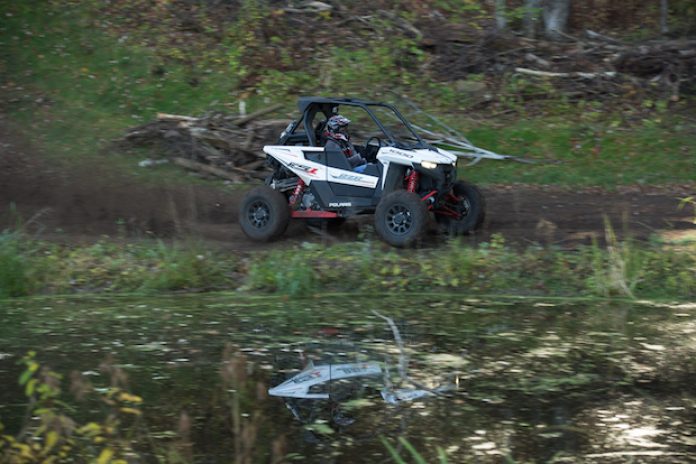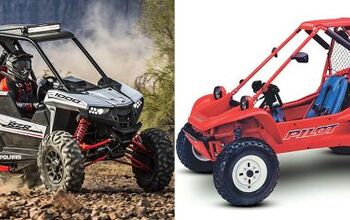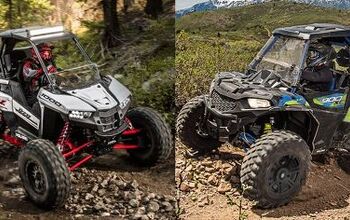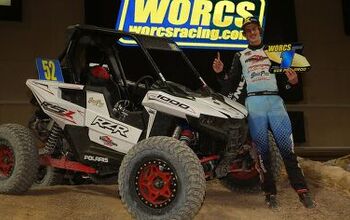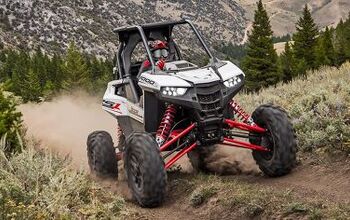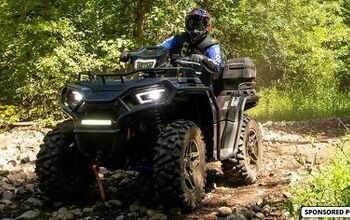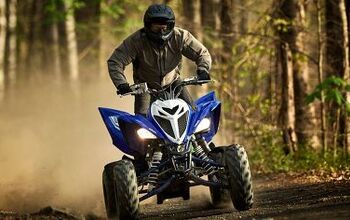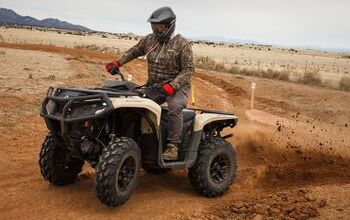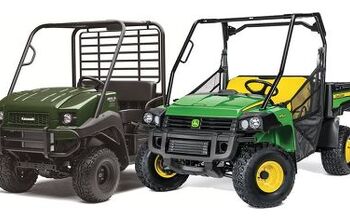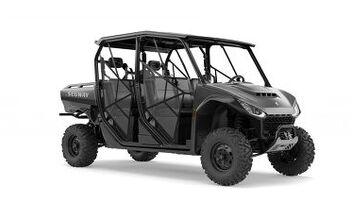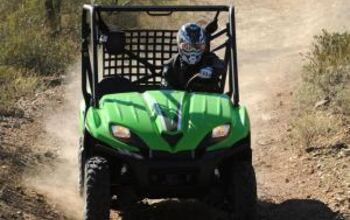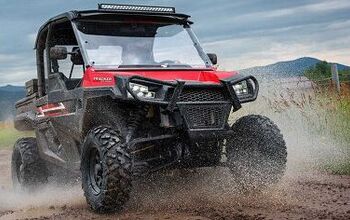2018 Polaris RZR RS1 Review
Base MSRP: $13,999
When I think of rally racing, I think of the Subaru WRX, Mitsubishi Eclipse and similar vehicles, whistling waste gates and all. A Side-by-Side is not my first thought as a purpose-built rally racer from the factory, but that is precisely what the all-new 2018 Polaris RZR RS1, which stands for Rally Sport 1, aims to be.
As Polaris has done many times in the past, the company is expanding upon a segment that it created; the single seat platform, introduced with the ACE lineup. However, as you might have imagined, this new RZR RS1 is SO much more than another ACE. In fact, it isn’t an ACE at all.
The centralized driver’s seat is the first giveaway that the RS1 is truly something different, and the larger chassis lets you know that it isn’t an ACE, either.
Providing the baseline for this RS1 is the RZR XP 1000 chassis. To inspire rally-style driving, the XP1000 chassis has been shortened seven inches overall for the RS1 platform, packing an 83-inch wheelbase and 64-inch width. This shortened wheelbase gives the vehicle more of a compact package overall, and also gives it more of a fun-to-drive characteristic when pushing through tree-lined trails or in the wide open deserts.
And for all those looking to modify the 2018 Polaris RS1, you can easily use the plethora of proven aftermarket components that are already on the market for the XP1000 chassis. This also means that you can expect similar specs on the RS1, including 16 inches of front wheel travel, damped by Walker Evans Needle shocks with 16-position adjustable compression clickers and 18 inches of rear wheel travel using 2.5-inch Walker Evans Needle shocks, again with 16-position adjustable compression clickers. Front and rear sway bars also come standard on this machine, and we’ll see how these effect the handling here in just a minute.
You might also notice how the front of the RS1 has a very short and downward slanted front fascia and essentially no front fenders. The reason for this is because the radiator has actually been moved to the rear of the vehicle, just above the engine. This effectively means that the cooling system is more efficient overall, and you don’t get that extra heat coming up from the cab as in other RZRs with the cooling lines passing through the central tunnel in the floorboard.
Further helping the cooling efficiency is a larger radiator, which has two brushless fans ensuring that any unwanted heat is dissipated. With this setup being over the engine of the vehicle, the RS1 does not have nearly as much rear storage capacity as a similar XP1000, which includes a recessed storage area. The RS1 does have a flat surface on the back that can hold 50 pounds of your gear, and Polaris makes an accessory bag for this area that can keep your extra items secure in the vehicle. There is also a storage box found under the hood of the vehicle, and though there isn’t too much room here (the battery is located underneath the storage box), it does allow you to store an extra jacket or other smaller items. The interior is laid out with a couple small storage pockets, too.
All in all, this radiator relocation and lower front hood allows the driver to have amazing visibility out the front of the vehicle, and we love how you can see the wheels so easily. However, long distance riders need to do some more planning to be able to carry their essentials in this machine. Also, mud riders beware, you’re going to want a set of extended fenders to help keep the muck where it should be, with the rest of the muck (but who am I kidding, that isn’t going to happen!).
Powering this rally-ready beast is a ProStar engine that is also transferred right from the XP 1000. The 110 horsepower, 999cc parallel twin-cylinder power plant is a proven engine option that has been around for many years. Electronic Fuel Injection controls the fuel delivery, and a high intake snorkel (it’s at the top of the ROPS cage system, just behind the driver’s head) ensures that plenty of clean air is being brought into the engine. One huge change compared to the XP 1000 is the addition of the turbo-model transmission and drivetrain components in the RS1. And, from our seat of the pants driving experience, you can feel the added strength or consistency of this drivetrain system after driving the 2018 Polaris RZR RS1 and the RZR XP 1000 back to back.
Open the lower half door on this machine and you are greeted by the center mounted seat. The hump in the floor under the seat is where the 9.5-gallon gas tank lies, and there is only a small hump in the center of the floor for the front driveshaft to pass through. Sit inside and you feel the familiar RZR seat here – it still needs some improvement with more lateral and bum bolstering. The gear shifter, starter, and switches are all on the right hand side of the cab. The dash, a la GENERAL, is attached to the steering column and has a great, clear readout for keeping an eye out on the machine’s vitals. Look down and you’ll find a two-stage brake pedal – it’s essentially two pedals in one for either drivers who prefer one-foot driving or two-foot driving. In theory, this is a great setup, and in practice it proves its mettle by working superbly.
Pushing the 2018 Polaris RZR RS1 hard through the forest, the instantaneous reactions of two-foot driving allowed me to round corners and flick the back end around with ease. Those who have driven the RZR platform know that it is already predictably fun to drive in many conditions, and this RS1 just amplifies the predictable and fun nature of this chassis with even better weight balance and mass centralization. When the driving got to a more cruising oriented pace, the one-foot style was comfortable. I will say that the two-foot side of the pedal is spaced further out than a traditional setup, so it takes a little getting used to initially, especially for those of us who drive with two feet more often than not. Once you’re used to it, it’s smooth sailing.
Since the comparison has been made that the RS1 is uniquely similar to the XP 1000, yet it has one less seat, you could make the assumption that it also weighs less overall. Well, the short story is that the RS1 only weighs a total of 11 pounds less than an XP 1000 (1358 lbs versus 1369 lbs, dry). Despite the little difference in weight, it is where the weight is located in the chassis that really matters, and that’s where the RS1 excels. With the driver’s positioning and the gas tank both located in the center of the vehicle, the weight balance of the RS1 is nothing short of phenomenal.
I could back it into corners at speed, in either 2WD or 4WD, with so much precision that I continually impressed myself. The RS1 is planted and confident when rallying through corners, and it feels even more confident when rocketing up and down hills. Down hills show you how confident the braking system is here, with triple-bore and dual-bore calipers in the front and rear, respectively, which is better than the XP 1000. The pedal feel is also very secure and confident, with just enough initial bite in the brake pedal for those quick turn ins, then the stopping power progressively gets more abrupt when you really stomp on the brakes. Plus, no matter what terrain we rode on, I love the bite out of the 29-inch Maxxis Bighorn tires, which are mounted on cast aluminum wheels.
If you have driven a RZR Turbo model in the past, then you will notice how that machine is definitely quicker than the RS1, but that isn’t to say that the RS1 is a slouch. I felt like it put the power to the ground even more efficiently than an XP 1000; credit those turbo components here. Was I super impressed by the power? Let’s put it this way: I didn’t think this machine needed any more power because it does so much with the power that it already has, but the fact is that the dune and desert guys are going to want to have more power in those environments. Still, we weren’t longing for more power at the end of our stint behind the wheel on the tree-lined trails. Also, the ROPS-mounted belt and engine cooling intakes were appreciated in the mudding and somewhat wet conditions we rode in Minnesota. We couldn’t slay a belt if we tried.
One of the other pluses we found with this 2018 Polaris RZR RS1 was on the maintenance and serviceability side of things. It shares a lot of parts with other machines, meaning that Polaris dealers should have parts in stock for you. Serviceability of the engine was a little tougher because the radiator is in the back, but I wouldn’t say that that should be a hindrance from buying one of these machines.
Overall, it’s a great package that is an absolute blast to drive. Polaris didn’t just make changes to the chassis; it made the right changes that make this machine stand out. If you like to ride on the 64-inch wide trails and don’t mind having a go at them alone, then this very well could be the machine for you. At an MSRP of $13,999, it’s also not a bad bargain, especially considering it plays in a segment of one.
We are sure there will be more to come with this machine, and maybe even some single-driver competition for it one day soon, so stay tuned as the side-by-side market continues to rapidly expand.
More by ATV.com




